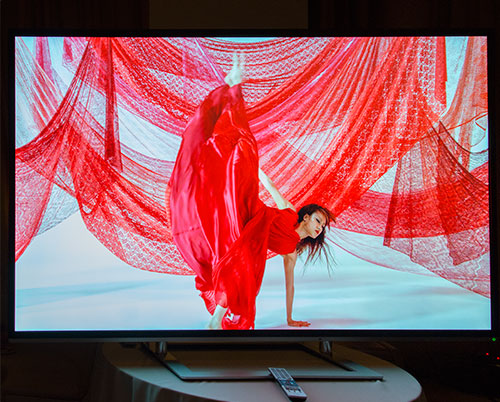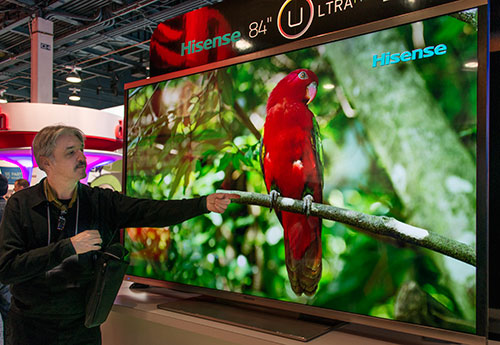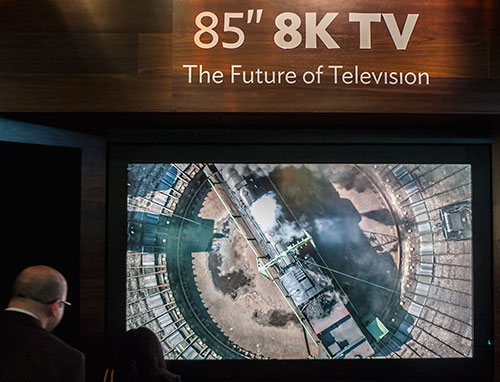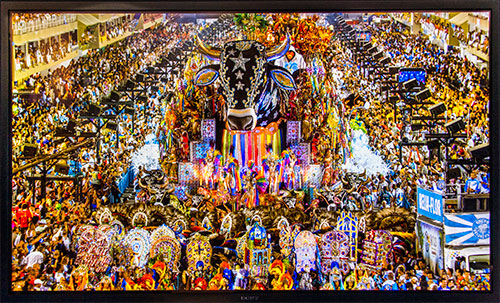
|
|
 |

|


 What in the Ultra HD World? What in the Ultra HD World?CES 2013 Round-up - Ultra HD TVs
Dick De Jong January 15, 2013 HDTV Solutions This year, the Consumer Electronics Show (CES) could be dubbed the coming out party for Ultra HD TVs. These displays have four times the resolution of those ol' run-of-the-mill 1080p HDTVs. (If you need an Ultra HD primer, you can start with an article that I wrote earlier and then continue reading my Ultra HD Progress Report.) Yes, the convention floor was strewn with smartphones, phablets, and tablets of various sizes - and sure, LG and Sony already have introduced their 84-inch Ultra HD TVs - but with at least ten TV manufacturers presenting their Ultra HD debutantes at CES, these beastly beauties seemed to be everywhere you turned in the Central Hall. And they were turning heads and causing traffic jams in the aisles. Even grizzled conventioneers would stop and linger for a moment, soaking up the 4K grandeur, before they shook out of their reverie and moved on as they continued grumbling about the good old days when CES didn't attract 150,000 visitors. But with headlines trumpeting $20,000 TVs, the average consumer may feel like they haven't been invited to this Ultra HD party. And currently, that may be true. We are on the outside looking in. Though you have to remember that $20,000 price tag is for an 84-inch Ultra HD TV, which is literally the size and resolution of four 42-inch 1080p TVs stacked two on two. 84 inches is a big, big screen and you would expect a like-sized sticker.  Add to that, the Ultra HD TV market was just birthed in late 2012 when LG rolled out their 84LM9600, (which I previewed here) and Sony countered with their $25,000 XBR-84X900. When other manufacturers like Samsung, VIZIO and Hisense (a newcomer to the U.S. market) release their Ultra HD models, the competition should heat up and prices should cool down. And of course, in this cutthroat TV marketplace MSRP is rarely the final price at the big box store, even for an Ultra HD, no matter how much the manufacturer may wish that it were. For example, LG's 84-inch (MSRP of $19,999) 84LM9600 was selling for a paltry $17,000 in December. More importantly for you or your significant other who can't imagine mounting a seven foot TV on your living room wall - or god forbid, above your fireplace - all the manufacturers are showing smaller-sized (commonly 55 and 65-inch) Ultra HD TVs, with less heart palpitating price tags.  LG's 84, 65 and 55-inch Ultra HD TVs In their CES 2013 press release, Westinghouse Digital states that their Ultra HD models will be available in the 50, 55 and 65-inch screen sizes in Q1 of 2013. And during a visit to their CES suite, their representative indicated that the 50-inch model would retail for under $3000, (though not surprisingly, no exact prices are listed on the press release.) Now some folks will argue that all those extra pixels on an Ultra HD display are wasted on a TV as small as 50 or 55 inches. (The contention is that at these sizes our eyes are not acute enough to physically see the difference between a 1920 x 1080 HD resolution and a 3840 x 2160 Ultra HD pixel count.) I will save that discussion for a later date. But if you are concerned that a 55-inch Ultra HD TV might be too small, you could always special order a 110-inch model (over nine feet diagonally) from Westinghouse or from various other vendors. Now, as for the cost of this behemoth, we are definitely entering, "if you have to ask..." territory.  Westinghouse 110-inch Ultra HD TV prototype Then again, if you could be satisfied with a mere piddling 55 or 65-inch Ultra HD TV, you shouldn't have to take out a second mortgage on your house. I wish that I could give you a better idea of how much a 55-inch model from a company like Samsung, Sony, or LG will cost, but it is simply too soon to say. Especially in this brand new marketplace, everyone is playing their cards close to their chests, waiting for someone else to show their hand, as is succinctly indicated on VIZIO's press release, "To be announced closer to product availability." We are definitely in the egg hatching days of Ultra HD TVs. Indeed, CEA forecasts that only 26,000 Ultra HD TVs will be sold in the U.S. in 2013. And they predict that it will be 2016 before the technology captures just 5% of the U.S. market with sales over 1.4 million units. With that preamble, let's take a look at some of the Ultra HD TVs that generated the chatter at CES. Before I begin, let me qualify my comments by stating that a crowded exhibit on a convention floor is definitely not the place to make informed judgments on a TV's Picture Quality, (PQ). Therefore, what I'm offering are quick impressions and general points to consider. Since Toshiba was showing a 4K Cell TV prototype at CES in 2009, let's start with their new 2013 L9300 Series of Ultra HD TVs. At a party at the top of THE Hotel, they unveiled their 84" model and it looked marvelous playing back native 4K material.  Toshiba's Ultra HD 84-inch L9300 Since there's a shortage of consumer-ready 4K content, Toshiba touts that with their second generation "proprietary CEVO 4K Quad+Dual Core Processor, L9300 Series TVs deliver the highest quality Ultra HD image processing." Toshiba plans to roll out 58, 65 and 84-inch L9300's this summer. No prices were revealed. (You can read the details in their press release.) On the same night, next door, Samsung was rolling out their 85-inch S9 UHD TV (as they label it). Their press release states, "With Samsung's Precision Black Pro technology, the S9 delivers deep, real blacks as well as pure vivacious whites. It combines an extremely high contrast ratio and Ultimate Dimming control functionality - which utilizes hundreds blocks of LEDs and precise BLU control - to deliver sharp resolutions previously unseen on large format displays." I'm a big proponent of local dimming and I think it might be especially effective on these uber-large screen TVs. The S9 looked gorgeous. Once again, they were displaying native 4K content.  Samsung 85-inch UHD S9 Of note, Samsung has implemented a design feature on the S9 that serves two functions. On first glance, it is simply a stand for the display. But if you turn up the volume, you will realize that the Samsung designers have integrated a fairly powerful speaker system into that stand (3-way 2.2 channels of 120 watt sound). Moving on to Westinghouse, my impression was that their Ultra HD offerings are more at the value end of the marketplace. They will produce 4K displays without a lot of high-end processing technology, which is not necessarily a bad thing. These lower priced models will allow many consumers an entry point into the Ultra HD world. I think we will be seeing companies like Oppo making Blu-ray players with higher-end HD to Ultra HD processors that can be paired well with a value-priced Ultra HD TV. The new kid on the block - at least in the U.S. market - Hisense is jumping into the Ultra HD ring with both feet. The Number 1 seller of TVs in the Chinese market plans to release two series of Ultra HD TVs, the XT880 in 50, 58 and 65-inch sizes and their flagship XT900series in 65, 84 and 110-inch sizes.  Hisense's Ultra HD 84-inch XT900 The XT900 looked tropically colorful on the convention floor. I will be anxious to get my hands on one of them since the designers have furnished "a rich feature set that includes WiFi-enabled Smart TV, active shutter 3D technology on vibrant 120Hz panels, and precise local dimming with mega dynamic contrast ratio." I'm also curious to see what exactly will be the "incredibly affordable prices," with which Hisense USA VP, Peter Erdman, entices us in the press release but never details how long we will have to wait for the XT900 release. VIZIO is also throwing its hat into the Ultra HD ring with three sizes (55, 65 and 70-inch) of their Ultra HD Razor LED Smart TV w/Theater 3D XVT Series.  VIZIO 70-inch Ultra HD Razor LED XVT70 I'm intrigued how VIZIO will approach pricing this new technology. If it's anything comparable to what they did with their $699 holiday sale of their 60" E601i LED HDTV, then the Ultra HD TV market may take off faster than most predict. Sharp is no stranger to big screen TVs. Their 90-inch HDTV is the largest commercially available. And Sharp also showed two entries in the Ultra HD arena. The first has the best description that I have read in a long while. "Developed jointly with I-cubed Research Center Inc., ICC Purios combines Ultra HD resolution and the ICC (integrated cognitive creation) image processor, which reproduces the 'cognitive' process by which the human brain interprets light stimuli. Employing this unique process provides a similar sense of depth, texture and perspective to what people experience when looking directly at an object for a lifelike viewing experience where everything is in sharper focus. The picture is so stunningly real, ICC Purios is the world's first display to pass the 400 tests necessary to receive THX® 4K Display certification, confirming that the display not only meets industry 4K performance guidelines, but that it maintains content accuracy true to the original HD image. This model will come to market summer 2013." Sharp, you had me at "integrated cognitive creation image processor." Though the real kicker is the THX certification. I can only imagine how much all this technology will cost. As a topper, Sharp exhibited an 8K TV, (one of our readers suggested they should label it super8HD), that was displaying native 8K (7680 x 4320 resolution). The images were startling in their dimensionality. But it's a bit too early to talk about 8K.  Lest we forget LG who already has skin in the Ultra HD game with a TV that you can actually go out and buy right now, the 84LM9600. They added 55 and 65-inch siblings to their Ultra HD family. LG was also a bit preoccupied with the rollout - finally - of its new OLED TV. But that's a discussion for another article. Though while we are broaching OLEDs, Sony sort of one-upped all the Ultra HD hoopla when Kazuo Hirai, Sony's CEO, spoke at their press conference and introduced a 56" 4K OLED prototype. His thunder was a bit muffled when just as the TV was rolling across the stage, that vibrant OLED image went blank. The 4K OLED TVs on the exhibit floor were simply brilliant. We might be waiting a long time before we see these lovelies roll off the production line in any quantities, which will give you an opportunity to save up your pennies and Krugerrands.  Sony's 56-inch 4K OLED Prototype TV In the meantime, Sony announced 65 and 55-inch additions to their X900A Ultra HD series and stated that these sizes would "put 4K within reach of a wider audience." We'll see. As always, stay tuned.
|
Bookmark:
![]() del.icio.us
del.icio.us
![]() Reddit
Reddit
![]() Google
Google
| Send this Page | Print this Page | Report Errors |

